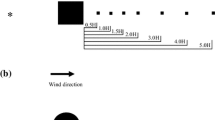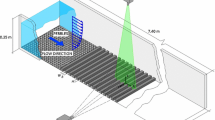Abstract
We report on measurements of the near-field dispersion of contaminant plumes in a large array of building-like obstacles at three scales; namely, at full-scale in a field experiment, at 1:50 scale in a wind-tunnel simulation, and at 1:205 scale in a water-channel simulation. Plume concentration statistics extracted from the physical modelling in the wind-tunnel and water-channel simulations are compared to those obtained from a field experiment. The modification of the detailed structure of the plume as it interacts with the obstacles is investigated. To this purpose, measurements of the evolution of the mean concentration, concentration fluctuation intensity, concentration probability density function, and integral time scale of concentration fluctuations in the array plume obtained from the field experiment and the scaled wind-tunnel and water-channel experiments are reported and compared, as well as measurements of upwind and within-array velocity spectra. Generally, the wind-tunnel and water-channel results on the modification of the detailed plume structure by the obstacles were qualitatively similar to those observed in the field experiments. However, with the appropriate scaling, the water-channel simulations were able to reproduce quantitatively the results of the full-scale field experiments better than the wind-tunnel simulations.
Similar content being viewed by others
References
Baechlin W, Theurer W, Plate EJ (1991) Wind field and dispersion in a built-up area—a comparison between field experiments and wind tunnel data. Atmos Environ 25A:1135–1142
Baechlin W, Theurer W, Plate EJ (1992) Dispersion of gases released near the ground in built-up areas: experimental results compared to simple numerical modelling. J Wind Eng Ind Aerodyn 41–44:2721–2732
Biltoft CA (2001) Customer report for mock urban setting test. DPG Document No. WDTC-FR-01-121, West Desert Test Center, U.S. Army Dugway Proving Ground, Dugway, Utah, 58 pp
Biltoft CA, Yee E, Jones CD (2002) Overview of the mock urban setting test (MUST)’ in Joint Sessions of 25th Conference on Agricultural and Forest Meteorology, 12th Joint Conference on the Applications of Air Pollution Meteorology with the Air and Waste Management Association, and Fourth Symposium on the Urban Environment, Norfolk, VA., May 20–24, pp J1–J2
Castro IP, Robins AG (1977) The flow around a surface-mounted cube in uniform and turbulent streams. J Fluid Mech 79:307–335
Counihan J (1975) Adiabatic atmospheric boundary-layers: a review and analysis of data from the period 1880–1972. Atmos Environ 9:871–905
Davidson MJ, Mylne KR, Jones CD, Phillips JC, Perkins RJ, Fung JCH, Hunt JCR (1995) Plume dispersion through large groups of obstacles—a field investigation. Atmos Environ 29:3245–3256
Davidson MJ, Snyder WH, Lawson RE Jr, Hunt JCR (1996) Wind tunnel simulations of plume dispersion through groups of obstacles. Atmos Environ 30:3715–3731
Deaves DM, Harris RI (1978) A mathematical model of the structure of strong winds, Construction Industry Research and Information Association (U.K.), Report 76, 49 pp.
Gailis R (2004) Wind tunnel simulations of the mock urban setting test—details on experimental procedures and data analysis. DSTO–TR–1532, DSTO Platform Sciences Laboratory, Fishermans Bend, Victoria, Australia, 47 pp
Gailis RM, Hill A (2006) A wind tunnel simulation of plume dispersion within a large array of obstacles. Boundary-Layer Meterol. DOI: 10.1007/s10546-005-9029-1.
Hall DJ, Macdonald R, Walker S, Spanton AM (1996) Measurements of dispersion within simulated urban arrays—a small scale wind tunnel study, BRE Client Report CR 77/96, Building Research Establishment, p. 112
Hanna SR, Briggs GA, Hosker RP (1982). Handbook on atmospheric diffusion. DOE/TIC-11223, Technical Information, U.S. Department of Energy, 102 pp.
Harris RI (1990) Some further thoughts on the spectrum of gustiness in strong winds. J Wind Eng Ind Aero dyn 33:461–477
Hosker RP (1984). Flow and diffusion near obstacles. In: Randerson D.(eds). Atmospheric science and power production. Technical Information Center, U.S. Department of Energy, Washington, D.C., pp. 241–326
Hosker RP (1985) Flow around isolated structures and building clusters: a review. ASHRAE Transactions 21(2B):1671–1692
Hilderman T, Chong R (2004) A laboratory study of momentum and passive scalar transport and diffusion within and above a model urban canopy – final report, Report Number CRDC00327, Coanda Research & Development Corporation, 70 pp.
International Organisation for Standardisation (1995) Guide to the expression of uncertainty in measurement. Geneva, Switzerland, 110 pp.
Lumley JL, Van Cruyningen I (1985). Limitations of second-order modelling of passive scalar diffusion. In: Davies SH, Lumley JL, (eds). Frontiers in fluid mechanics. Springer-Verlag, Berlin, pp. 199–218
Macdonald RW, Griffiths RF, Cheah SC (1997) Field experiments of dispersion through regular arrays of cubic structures. Atmos Environ 31:783–795
Macdonald RW, Griffiths RF, Hall DJ (1998a) A comparison of results from scaled field and wind tunnel modelling of dispersion in arrays of obstacles. Atmos Environ 32:3845–3862
Macdonald RW, Griffiths RF, Hall DJ (1998b) An improved method for estimation of surface roughness of obstacle arrays. Atmos Environ 32:1857–1864
Meroney RN (1982). Turbulent diffusion near buildings. In: Plate EJ (eds). Engineering meteorology. Elsevier, Amsterdam, pp. 481–525
Mylne KR (1993) The vertical profile of concentration fluctuations in near-surface plumes. Boundary-Layer Meteorol 65:111–136
Mylne KR, Mason PJ (1991) Concentration fluctuation measurements in a dispersing plume at a range of up to 1000 m’. Quart J Roy Meteorol Soc 117:177–206
Panofsky HA, Dutton JA (1984) Atmospheric turbulence, models and methods for engineering applications. John Wiley & Sons, New York, 418 pp
Pasquill FA, Smith FB (1983) Atmospheric diffusion, 3rd edn. Wiley, New York, 437 pp
Robins AG (1978) Plume dispersion from ground level sources in simulated atmospheric boundary layers. Atmos Environ 12:1033–1044
Standards Association of Australia (1989) Minimum design load on structures (Known as the SAA Loading Code)—wind loads, AS 1170.2-1989, North Sydney, Australia, 96 pp.
Stern AC, Boubel RW, Turner DB, Fox DL (1984) Fundamentals of air pollution. 2nd edn. Academic Press Inc., San Diego, California, 530 pp
Stull RB (1988) Introduction to boundary-layer meteorology. Kluwer Academic Publishers, Dordrecht The Netherlands, 666 pp
Snyder W (1981) Guidelines for fluid modelling of atmospheric dispersion, Report Number EPA–600/8–81–009, Environmental Protection Agency, Research Triangle Park, North Carolina, 200 pp
Theurer W (1999) Typical building arrangements for urban air pollution modelling. Atmos Environ 33:4057–4066
Theurer W, Plate EJ, Hoeschele K (1996) Semi-empirical models as a combination of wind tunnel and numerical dispersion modelling. Atmos Environ 30:3583–3597
von Karman T (1948) Progress in statistical theory of turbulence. Proc Natl Acad Sci (USA) 34:530–539
Warhaft Z (1984) The interference of thermal fields from line sources in grid turbulence. J Fluid Mech 144:363–387
Yee E, Biltoft CA (2002a) Preliminary results of the MUST diffusion experiment. In: Fourth symposium on the urban environment, Norfolk, VA, May 20–24, pp 143–144
Yee E, Biltoft CA (2002b) On the structure of plumes dispersing through a large array of obstacles. in Sixth Annual George Mason University Transport and Dispersion Modelling Workshop, Fairfax, VA
Yee E, Biltoft CA (2004) Concentration fluctuation measurements in a plume dispersing through a regular array of obstacles. Boundary-Layer Meteorol 111:363–415
Yee E, Chan R, Kosteniuk PR, Chandler GM, Biltoft CA, Bowers JF (1994) Experimental measurements of concentration fluctuations and scales in a dispersing plume in the atmospheric surface layer obtained using a very fast response concentration detector. J Appl Meteorol 33:996–1016
Yee E, Chan R, Kosteniuk PR, Chandler GM, Biltoft CA, Bowers JF (1995) The vertical structure of concentration fluctuation statistics in plumes dispersing in the atmospheric surface layer. Boundary-Layer Meteorol 76:41–67
Yee E, Kosteniuk PR, Chandler GM, Biltoft CA, Bowers JF (1993) Statistical characteristics of concentration fluctuations in dispersing plumes in the atmospheric surface layer. Boundary-Layer Meteorol 65:69–109
Author information
Authors and Affiliations
Corresponding author
Rights and permissions
About this article
Cite this article
Yee, E., Gailis, R.M., Hill, A. et al. Comparison of Wind-tunnel and Water-channel Simulations of Plume Dispersion through a Large Array of Obstacles with a Scaled Field Experiment. Boundary-Layer Meteorol 121, 389–432 (2006). https://doi.org/10.1007/s10546-006-9084-2
Received:
Accepted:
Published:
Issue Date:
DOI: https://doi.org/10.1007/s10546-006-9084-2




